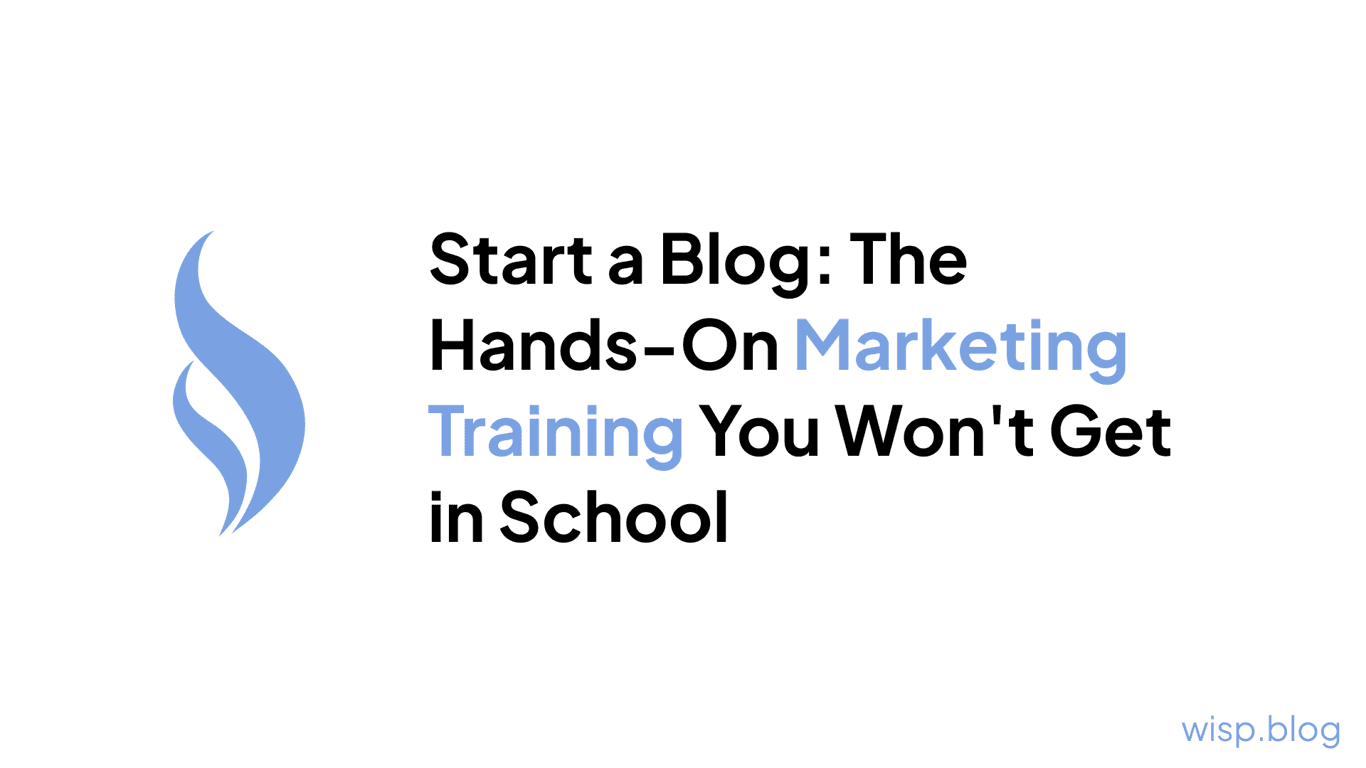
You're a marketing student or recent grad, and you're feeling frustrated. You've taken all the right classes, gotten good grades, and checked all the academic boxes. But when you apply for marketing jobs, you keep getting passed over for candidates with more real-world experience under their belts.
Deep down, you know you have the skills and passion to be an amazing marketer. But your resume is filled with coursework and theoretical knowledge, not tangible proof of your abilities. How can you stand out and show employers you're not just book-smart, but capable of driving real marketing results?
It's a tough catch-22 - you need experience to get hired, but you can't get hired without experience. You're worried that your academic credentials alone won't be enough to impress hiring managers. They want to see that you can actually execute marketing campaigns, not just regurgitate textbook concepts.
You've heard horror stories of other grads getting stuck in low-level roles because they couldn't demonstrate practical skills. Or worse, not even getting interviews because their resumes looked like everyone else's. The thought of wasting your expensive degree and passion for marketing is soul-crushing.
Maybe you're wondering if you should have pursued a more technical field, or if marketing was the wrong choice altogether. But you know in your heart that this is your calling - you just need a way to prove your worth.
Build your Marketing Portfolio
What if I told you there's a way to bypass the experience gap and position yourself as a world-class marketing hire from day one? By building a compelling marketing portfolio that showcases your skills in action, you can demonstrate your abilities in a way that no resume or transcript ever could.
A great marketing portfolio doesn't just list the classes you took or projects you completed for a grade. It highlights real-world marketing campaigns you've planned and executed, showing quantifiable results that any employer would be impressed by.
With a standout portfolio, you can make hiring managers say "Wow, I need to hire this person!"
1. Identify Your Marketing Specialties
The first step is identifying 2-3 key areas of marketing you want to specialize in for your portfolio. This allows you to build depth and cohesive narratives rather than appearing like a generalist.
Some specialties to consider:
Digital marketing (paid ads, SEO, email, etc.)
Content marketing (blogs, video, podcasting)
Social media marketing
Influencer marketing
Product marketing
Brand marketing
Marketing analytics
Marketing operations/automation
Spend some time reflecting on your biggest strengths, interests, and passions within marketing. Look for overlaps between what you enjoy and are skilled at, and what's in high demand from employers.
For example, if you're highly analytical but also a strong writer, marketing analytics and content marketing could be good focuses. If you're highly creative and love social media, specializing in social media and influencer marketing makes sense.
2. Complete Real Client Projects (Even If Unpaid)
The most valuable pieces for your portfolio will be full marketing campaigns you've executed for real clients, even if unpaid at first. This forces you to navigate real business challenges and prove your abilities in a way that classroom projects can't.
Get Experience Through:
Local small businesses
Nonprofits or community organizations
Personal brands (coaches, authors, etc.)
Campus clubs or student organizations
Family/friends' side businesses
Pitch them on letting you own a full marketing campaign or initiative for free in exchange for portfolio material and a testimonial. For example, you could offer to:
Revamp their website and drive more traffic through SEO
Plan and execute a lead generation campaign for a new product/service
Develop a comprehensive social media marketing strategy
Run their email marketing and nurture sequences
Rebrand them with a new logo, messaging, and creative assets
Treat it like a real client engagement - have kick-off meetings, set goals and KPIs, create a strategy document, execute the plan, analyze results, and document the whole process.
3. Launch Your Own Passion Project
If you can't find client work, create your own passion project from scratch that you can use as a marketing sandbox. This allows you to get experience in every aspect of marketing a new brand, product, or creative endeavor.
Some passion project ideas:
Start a blog or YouTube channel around a hobby/interest
Launch a podcast in a niche you're passionate about
Create an Etsy store or dropshipping business selling a product
Build a portfolio website to market your services
Start a local meetup group or community
Document your process for things like:
Conducting market research and identifying opportunities
Developing branding and messaging
Building a website and optimizing it for SEO
Creating lead magnets and nurture sequences
Promoting through content, social media, ads, etc.
Analyzing performance data and iterating
Essentially, you get to play the role of VP of Marketing and own the entire strategy from ideation to execution.
4. Contribute to Open-Source Projects
Open-source projects are often in need of marketing help and can be a great way to gain experience. Look for products, tools, or communities you're already involved in and passionate about.
Some ways to contribute:
Help manage their social media channels
Write blog posts, tutorials, or other educational content
Grow and nurture their email lists
Promote the project through community outreach
Develop creative assets like videos or infographics
Analyze their metrics and provide optimization suggestions
Not only do you get hands-on experience, but you build relationships with developers and companies that could lead to job opportunities. Contributing code isn't required - they need marketing help too.
5. Redesign Existing Brands/Campaigns
If you can't execute full campaigns from scratch, analyze and provide improvements to existing marketing campaigns from brands you admire. Dissect their strategies, creative execution, channels, and performance.
Then, rebuild their campaigns from the ground up, documenting how you'd approach it differently for better results. For example:
Conduct a brand messaging and positioning exercise
Redesign their website with a tighter user experience
Rebuild their email nurture sequences with more effective copy and CTAs
Relaunch their social media presence with a more cohesive content strategy
Reimagine their advertising creative with more compelling visuals and copy
This demonstrates your strategic thinking, creativity, and ability to optimize and improve on existing marketing efforts. It's a great way to showcase your skills when you can't access real performance data.
6. Tell a Compelling Story
For each major portfolio piece, craft a detailed narrative that provides context around the project. Don't just describe what you did, but explain:
The "why" behind your strategic approach
The research and insights that informed your decisions
Your process for planning and executing the project
Any challenges you faced and how you overcame them
The results you achieved with key metrics/data
What you learned and how you'd iterate or do things differently next time
Storytelling is a critical marketing skill. By writing compelling narratives, you demonstrate strong communication abilities and your level of strategic thinking.
7. Use a Modern Portfolio Platform
Ditch the old PDF resume in favor of a visually-appealing, easy-to-navigate online portfolio. This shows you have an eye for design and understand the importance of user experience.
Some great portfolio platform options:
Personal website/blog (WordPress, Ghost, etc.)
Website builders like Wix, Squarespace, etc.
Modern site generators like Next.js, Gatsby, etc.
For example, you could use a Next.js blog template like this one to easily deploy a fast, SEO-friendly portfolio site on Vercel with minimal coding required.
Your portfolio site should have a clean, professional design with clear sections for your about page, portfolio pieces, resume, and contact info. Make it easy for employers to navigate and digest your best work.
8. Quantify Your Results
The most compelling portfolio pieces aren't just descriptions of what you did, but hard data that proves the impact you made. Quantify your results as much as possible with key metrics like:
Website traffic and engagement numbers
Email marketing metrics (open rates, click-through rates, etc.)
Lead generation and conversion numbers
Sales figures and revenue generated
Social media engagement (shares, comments, etc.)
SEO performance (keyword rankings, etc.)
Advertising performance (CPCs, CPAs, ROI, etc.)
Any other numbers that demonstrate growth
This turns your portfolio from a self-reported resume into irrefutable proof that you can drive real, measurable business results as a marketer.
9. Get Endorsements
In addition to showcasing your own work, get endorsements from any clients, managers, professors, or others you collaborated with. Testimonials and positive reviews from third-parties add credibility to your portfolio.
Ask them for quotes highlighting specific skills and strengths you demonstrated, such as:
Project management abilities
Communication and client relationship skills
Teamwork and ability to take feedback
Creativity and innovative thinking
Ability to hit goals and deliver results
Strong work ethic and reliability
These endorsements validate that you're not just skilled in marketing tactics, but someone who is professional, accountable, and great to work with.
10. Keep a Blog as a Side Project
Maintaining an active blog or content hub is one of the best side projects you can have, especially if you want to go into content marketing, SEO, or any technical marketing role.
A blog allows you to demonstrate skills like:
Content creation and promotion
On-page SEO and keyword research
Analytics and data analysis
Conversion rate optimization
Social media marketing and distribution
Marketing automation and email nurturing
Coding and web development (depending on your stack)
You can embed analytics dashboards, share content performance metrics, document SEO strategies, and provide behind-the-scenes looks at your marketing processes.
It's also a chance to build authority in your niche by educating your audience on topics you're knowledgeable about. This helps reinforce your subject matter expertise to potential employers.
For example, you could build your blog using the Next.js Starter Blog template to get experience with the React framework and deploying on Vercel's platform.
Start Today!
With a standout marketing portfolio showcasing your skills in action, you can bypass the experience gap and position yourself as an invaluable hire from day one. By highlighting your passion projects, client work, quantifiable results, and endorsements, you'll prove you have what it takes to drive real business impact as a marketer.
An impressive portfolio makes you irresistible to employers who want ambitious, talented marketers ready to hit the ground running. With this guide, you can turn your academic credentials into a launchpad for your marketing career.


